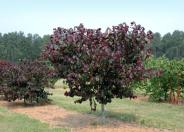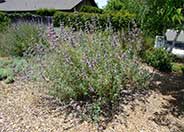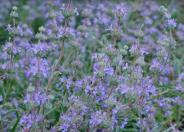
Common name:Merlot Eastern Redbud
Botanical name:Cercis canadensis 'Merlot'
Cercis canadensis 'Merlot'™ is a Canadensis and texensis cross to produce a more drought and heat-tolerant tree. It has glossy, small rounded dark purple leaves and has an upright vase-shaped growth habit. It has a tighter, denser habit than Cercis "Forest Pansy" and is more heat tolerant and drought tolerant (texensis factor.) Leaves of 'Merlot'™ are smaller, thicker, and glossier than those of 'Forest Pansy'™. Mature plants flower heavily with strong bright pink, self-cleaning flowers and have a low seed set. 'Merlot'™ does not show leaf stress in the heat of summer.

Common name:Dwarf Compact Heavenly Bamboo
Botanical name:Nandina domestica 'Nana'
The ' Nana' is a small, rounded shrub that grows from 12"-15" high. Its growth habit is dense, and the leaves become bright red in color in cold winter areas. It can receive sun to part shade, and is used well as an accent plant.

Common name:Cleveland Sage
Botanical name:Salvia clevelandii
The Cleveland Sage is a perennial shrub that grows 4' tall and wide. It has fragrant gray foliage and blue flowers that bloom between May and August. This shrub needs full sun and prefers well drained soil. The Cleveland Sage is native to California and is drought tolerant.

Common name:Kleinia
Botanical name:Senecio mandraliscae
This succulent perennial will grow to about 1.5' tall and 2' wide. It has curved, bluish gray leaves that are about 3.5" long and very slender.

Common name:Red Yucca
Botanical name:Hesperaloe parviflora
This spectacular succulent grows to 3'-4' tall and wide. Blue green leaves are strap-like, leathery, long, with white fraying fibers on the edges. During the summer, dark pink flowers are seen on red flower arching stalks. Hummingbirds love these flowers. This evergreen plant is drought tolerant once it's established but will appreciate extra water during the summer to promote blooms. Plant in full sun or light shade, with well draining soil. Deer like the foliage. This plant looks great in pots.
Permeable pavers

Common name:Deergrass
Botanical name:Muhlenbergia rigens
The Deergrass is a warm-season perennial that forms dense clumps from the base. The spike-like flower stalks grow 2'-3' tall and this grass has a striking foundation form. The Deergrass is native to California and needs watering once or twice a month after it has been established. The more water it has, the greener it is.

Common name:Bee's Bliss Purple Sage
Botanical name:Salvia leucophylla 'Bee's Bliss'
This reliable shrub/ground-cover reaches 1'-1.5' tall and 4'-6' wide. It is used as a ground cover on slopes or cascading over walls. The evergreen leaves are gray green, narrow, and soft looking, During spring and summer clusters of lavender blue flowers appear above foliage. This sage prefers full sun with well draining soil. It does not like overhead irrigation as it promotes mildew. It is drought tolerant once it's established.

Common name:Coast Live Oak
Botanical name:Quercus agrifolia
Coast Live Oak (Quercus agrifolia) is one of the best trees for California native or California-friendly gardens. It grows very well from the coastal areas to the interior valleys. It is an evergreen tree that can reach 25’-70' tall and up to 70' wide, so make sure you have the space in your garden to support it. It is considered very low-water-use and is susceptible to root rot in gardens that are over-irrigated. Plant it with other California natives or low-water plants and stick to a watering cycle that includes watering during the fall, winter, and spring with no supplemental water in the summer. The tree is a slow grower and has an irregular shape when it is young, so it is important to make minimal pruning cuts to improve the look of the canopy. Over-pruning or hedging can take years to recover from, so consult or hire a licensed arborist when the shaping becomes out of your reach. This tree will eventually become a large shade tree; therefore, the plant selection around it may need to be adjusted as it matures. This tree should be planted at least five feet away from any hardscape areas, 20 feet from structures such as houses and buildings, and not near any powerlines. Shrubs and perennials should be planted about four feet away from this tree. It should be irrigated for about 45 minutes once a week when using most in-line drip irrigation systems.

Common name:Chilean Mesquite
Botanical name:Prosopis 'Phoenix'
Hybrid that has strong rooting and also results in a healthy branching structure. Will reach a mature size of 30'. In the low desert, this tree is semi-evergreen with lush green compound leaves. Clusters of yellow flowers appear in the spring. Accepts full sun. Drought tolerant. Limit water to control rapid growth and windstorm uprooting.
Designer: Amelia Herndon-Steen, SMWD
Photographer: SMWD
Practice grass-cycling by leaving short grass clippings on lawns after mowing, so that nutrients and organic matter are returned to the soil.
Attract, or buy beneficial insects such as ladybugs and lacewings to control pest outbreaks in your garden.